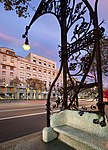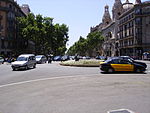Òmnium Cultural
Òmnium Cultural (Catalan pronunciation: [ˈɔmni.um kultuˈɾal]) is a Catalan association based in Barcelona, Catalonia. It was originally created in the 1960s to promote the Catalan language and spread Catalan culture. Over the years it has increased its involvement in broader political issues; in 2012 it committed itself to Catalan independence, specifically demanding the right of self-determination for Catalonia. Leaders of the abortive Catalan independence referendum such as Jordi Cuixart were simultaneously holding leadership positions at Òmnium. Currently Òmnium claims more than 190,000 members organised in 52 regional offices besides the headquarters in Barcelona.
Excerpt from the Wikipedia article Òmnium Cultural (License: CC BY-SA 3.0, Authors).Òmnium Cultural
Carrer de la Diputació, Barcelona
Geographical coordinates (GPS) Address Nearby Places Show on map
Geographical coordinates (GPS)
| Latitude | Longitude |
|---|---|
| N 41.391666666667 ° | E 2.1691666666667 ° |
Address
Carrer de la Diputació 274
08001 Barcelona
Catalonia, Spain
Open on Google Maps









